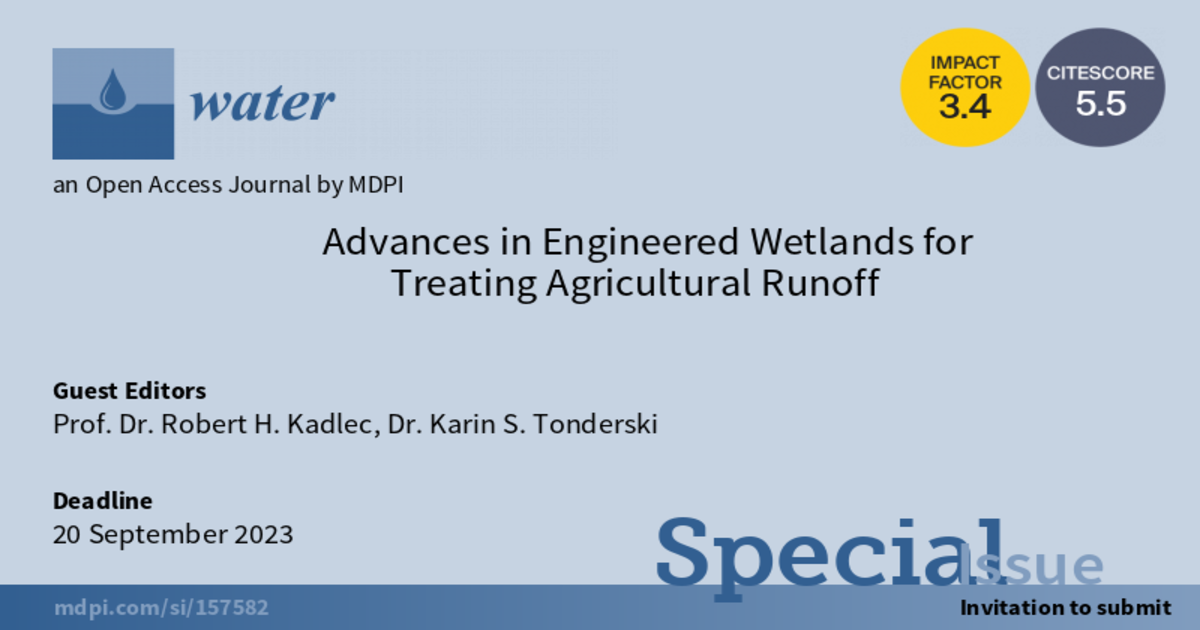Advances in Engineered Wetlands for Treating Agricultural Runoff
A special issue of Water (ISSN 2073-4441). This special issue belongs to the section "Water Quality and Contamination".
Deadline for manuscript submissions: closed (20 September 2023) | Viewed by 3899

Special Issue Editors
Interests: constructed wetlands; pollution control; nutrients; sediments; marsh hydraulics
Special Issue Information
Dear Colleagues,
Modern agriculture produces high yields of crops that are necessary for life, but it also produces runoff that may have large impacts on the receiving waterbodies. This non-point discharge contains nutrients, often dominated by nitrogen (N), in the form of nitrate, and phosphorus (P), along with suspended solids. The runoff also often contains pesticide residues, used to prevent insect damage and control weeds. Efforts are well under way to prevent damage to the Gulf of Mexico, Lake Erie, the Baltic Sea, and other sensitive receiving waterbodies. However, there remains a further critical need to prevent contaminants from reaching receiving waters, which can be partly achieved by best management practices. End-of-field buffer systems can provide major reductions, and these prominently include constructed wetlands (CWs).
It has been thirty years since the pioneering work of the US Department of Agriculture (Wengrzynek and Terrell, 1990) and the Swedish Meteorological and Hydrological Institute (Arheimer and Wittgren, 1994) regarding CWs for treating agricultural runoff. Hundreds of wetlands for runoff control have been created. These wetlands vary greatly depending on the crop and the site conditions. In the Yakima Valley of Washington State, runoff is from corn, wheat, peppers, cherries, peaches, mint, and grapes. In the midwestern US, corn and wheat dominate the landscape. In Florida, we find vast sugarcane fields. The same holds for all other regions of our planet. The result has been a wide variety of “recipes” for implementing wetland buffers. Despite this diversity, there is an underlying commonality of wetland biogeochemistry.
Although wetlands are already being successfully implemented in many locations, there is plenty of room for more science and engineering to increase wetland effectiveness. Wetlands are a “low tech” remedy, but they can be made more effective if the science is better understood.
The goal of this Special Issue is to present current advances in the knowledge base for wetland systems intended to control nutrients, solids, and pesticides in agricultural runoff.
Prof. Dr. Robert H. Kadlec
Dr. Karin S. Tonderski
Guest Editors
Manuscript Submission Information
Manuscripts should be submitted online at www.mdpi.com by registering and logging in to this website. Once you are registered, click here to go to the submission form. Manuscripts can be submitted until the deadline. All submissions that pass pre-check are peer-reviewed. Accepted papers will be published continuously in the journal (as soon as accepted) and will be listed together on the special issue website. Research articles, review articles as well as short communications are invited. For planned papers, a title and short abstract (about 100 words) can be sent to the Editorial Office for announcement on this website.
Submitted manuscripts should not have been published previously, nor be under consideration for publication elsewhere (except conference proceedings papers). All manuscripts are thoroughly refereed through a single-blind peer-review process. A guide for authors and other relevant information for submission of manuscripts is available on the Instructions for Authors page. Water is an international peer-reviewed open access semimonthly journal published by MDPI.
Please visit the Instructions for Authors page before submitting a manuscript. The Article Processing Charge (APC) for publication in this open access journal is 2600 CHF (Swiss Francs). Submitted papers should be well formatted and use good English. Authors may use MDPI's English editing service prior to publication or during author revisions.
Keywords
- constructed wetlands
- agricultural runoff
- nitrogen
- phosphorus
- sediments
- pesticides
- ecological engineering
Benefits of Publishing in a Special Issue
- Ease of navigation: Grouping papers by topic helps scholars navigate broad scope journals more efficiently.
- Greater discoverability: Special Issues support the reach and impact of scientific research. Articles in Special Issues are more discoverable and cited more frequently.
- Expansion of research network: Special Issues facilitate connections among authors, fostering scientific collaborations.
- External promotion: Articles in Special Issues are often promoted through the journal's social media, increasing their visibility.
- e-Book format: Special Issues with more than 10 articles can be published as dedicated e-books, ensuring wide and rapid dissemination.
Further information on MDPI's Special Issue polices can be found here.






